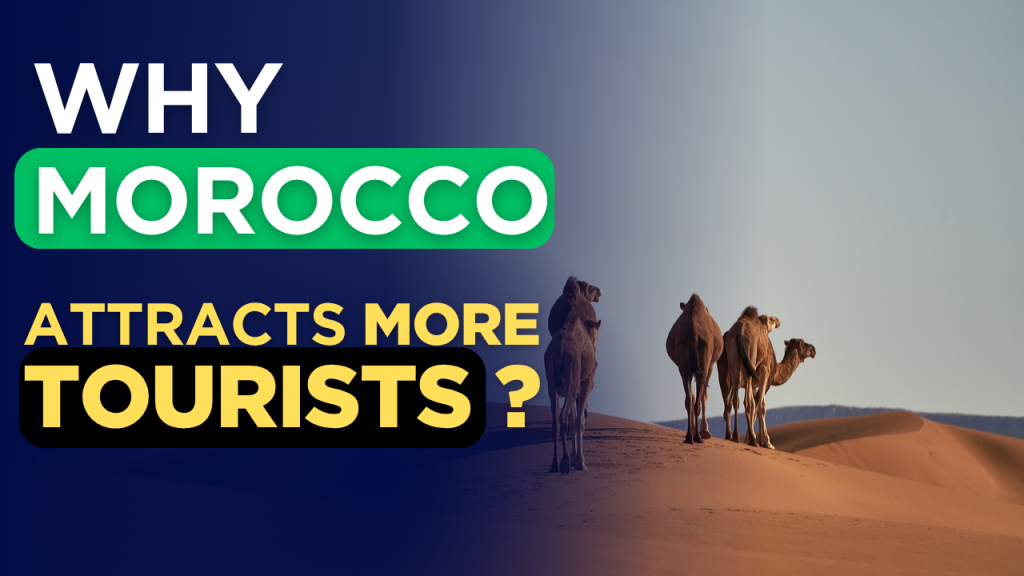Morocco, a land of captivating contrasts, has steadily cemented its position as a top global tourist destination. From the bustling souks of Marrakech to the tranquil dunes of the Sahara, this North African gem offers a kaleidoscopic array of experiences that appeal to a diverse range of travelers. Its enduring appeal lies in a unique blend of breathtaking natural beauty, a rich tapestry of cultural heritage, renowned hospitality, strategic accessibility, and a continuously evolving infrastructure. This potent combination creates an irresistible draw, ensuring Morocco’s place on the must-visit list for countless adventurers and culture seekers worldwide.
The extraordinary geographical diversity of Morocco
One of Morocco’s most compelling attractions is its extraordinary geographical diversity. The country boasts a remarkable spectrum of landscapes within relatively short distances, allowing visitors to experience multiple worlds in a single trip. Along its extensive coastline, the sun-drenched beaches of the Mediterranean, like those near Tangier and Saïdia, offer serene relaxation, while the wild Atlantic shores, particularly around Essaouira and Agadir, are a mecca for surfers and water sports enthusiasts. Inland, the majestic Atlas Mountains carve a dramatic spine across the country. These ranges, including the High Atlas with Mount Toubkal, invite adventurers for hiking, trekking, and exploring traditional Berber villages nestled in verdant valleys. The stark beauty of the Rif Mountains in the north offers a different, greener mountain experience. Perhaps most iconic is the mystical Sahara Desert. The towering dunes of Erg Chebbi and Erg Chigaga provide an unforgettable backdrop for camel treks, starlit desert camps, and a profound sense of timelessness and adventure that is truly unique. This incredible variety ensures that whether a traveler seeks sun-soaked beaches, challenging mountain trails, or an otherworldly desert escape, Morocco delivers.
Rich and layered cultural heritage
Beyond its natural splendor, Morocco is steeped in a rich and layered cultural heritage that is a constant source of fascination. The country’s history is a vibrant mosaic of Berber, Arab, and Andalusian influences, palpable in its architecture, music, cuisine, and daily traditions. The Imperial Cities stand as magnificent testaments to this heritage. Marrakech, often dubbed the “Red City,” pulsates with energy, particularly in the UNESCO-listed Jemaa el-Fnaa square, where storytellers, musicians, and food stalls create an intoxicating sensory experience. Its labyrinthine souks, the opulent Bahia Palace, and the iconic Koutoubia Mosque beckon exploration. Fez, the spiritual and cultural capital, offers a journey back in time. Its ancient medina, Fes el-Bali, is one of the world’s best-preserved medieval cities, home to the Chouara Tannery and the Al-Attarine Madrasa, showcasing exquisite Islamic architecture. Rabat, the modern capital, blends historical sites like the Hassan Tower and the Oudayas Kasbah with contemporary urban development. Meknes, with its monumental Bab Mansour gate and proximity to the Roman ruins of Volubilis, adds another historical dimension. These cities, each with its distinct character, allow visitors to immerse themselves in centuries of history and living traditions.
The warmth and genuine hospitality of the Moroccan people
The warmth and genuine hospitality of the Moroccan people are consistently highlighted as a major draw for tourists. Known for their welcoming nature and generosity, Moroccans embrace the concept of “Diyafa” (hospitality) wholeheartedly, often inviting strangers for a glass of mint tea – a cherished cultural ritual. This inherent friendliness transforms a mere visit into an authentic cultural exchange. Accommodations often reflect this ethos, with traditional riads and dars (restored courtyard houses) offering intimate and personalized stays that immerse guests in local charm. Beyond structured tours, visitors can engage in myriad authentic experiences, from hands-on cooking classes to traditional hammam rituals, or simply engaging in friendly banter with local artisans in the souks. This human connection fosters a sense of belonging and creates lasting memories for visitors.
The strategic geographical location
Morocco’s strategic geographical location plays a significant role in its appeal. Situated at the crossroads of Europe and Africa, it is remarkably accessible. Short flights from major European cities make it an ideal destination for weekend getaways or longer holidays. Furthermore, regular ferry services across the Strait of Gibraltar provide an easy link for travelers from Spain. Beyond Europe, increasing air connectivity with North America and other regions via its modernized airports, such as Mohammed V International Airport in Casablanca, continues to expand its reach. The country’s relatively straightforward visa policies for many nationalities also contribute to its accessibility, simplifying the travel planning process for a broad international audience.
The visitors safety

Finally, Morocco’s commitment to developing its infrastructure and ensuring visitor safety has been instrumental in its tourism growth. Significant investments have been poured into modernizing transportation networks, including the continent’s first high-speed train, Al Boraq, connecting key cities like Tangier and Casablanca, with plans to extend to Marrakech and Agadir by 2030. Road networks have been vastly improved, making inter-city travel smoother. The government has also actively promoted the development of high-quality hotels and resorts, catering to various budgets and preferences. Coupled with a strong emphasis on tourist safety and security, these infrastructural advancements provide a comfortable and secure environment for visitors, further enhancing Morocco’s reputation as a reliable and enjoyable travel destination. The country’s proactive “Morocco Tourism Strategy 2023-26” and its ambition to welcome 26 million tourists by 2030, supported by significant investments in airport and railway infrastructure, underscore its dedication to the sector.
Conclusion
In conclusion, Morocco’s consistent ability to attract a growing number of international tourists is a multifaceted phenomenon. It is a harmonious symphony of diverse natural landscapes – from sun-drenched coasts to majestic mountains and the timeless desert – combined with a deeply rooted cultural heritage that comes alive in its imperial cities and ancient traditions. This is further amplified by the genuine warmth of its people, its convenient geographical position, and ongoing efforts to enhance infrastructure and ensure a safe, welcoming experience. As Morocco continues to evolve, embracing sustainable tourism practices and modern amenities while fiercely preserving its unique identity, its enchanting allure is set to captivate hearts and minds for generations to come, truly establishing it as a “four-season destination.”
Related article : Why Morocco should be your next destination as a tourist
Planning your trip to Morocco ? Contact us now to reserve your seat


Pingback: Is Agadir Worth Visiting? 8 Reasons to Add Agadir to Your Morocco Itinerary in 2025 - Tasga